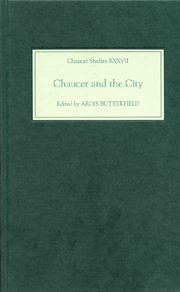Book contents
- Frontmatter
- Contents
- List of Illustrations
- Dedication
- Preface
- List of Contributors
- Abbreviations
- Map
- INTRODUCTION
- LOCATIONS
- COMMUNITIES
- 5 Chaucer and the Language of London
- 6 The Canterbury Tales and London Club Culture
- 7 London and Southwark Poetic Companies: ‘Si tost c'amis’ and the Canterbury Tales
- INSTITUTIONS
- AFTERLIVES
- Bibliography
- Index
- CHAUCER STUDIES
5 - Chaucer and the Language of London
from COMMUNITIES
Published online by Cambridge University Press: 05 February 2013
- Frontmatter
- Contents
- List of Illustrations
- Dedication
- Preface
- List of Contributors
- Abbreviations
- Map
- INTRODUCTION
- LOCATIONS
- COMMUNITIES
- 5 Chaucer and the Language of London
- 6 The Canterbury Tales and London Club Culture
- 7 London and Southwark Poetic Companies: ‘Si tost c'amis’ and the Canterbury Tales
- INSTITUTIONS
- AFTERLIVES
- Bibliography
- Index
- CHAUCER STUDIES
Summary
As the dreamer in Piers Plowman looks down into the ‘deep dale’ beneath the ‘tour’, what at first appears to be ‘alle manere of men … werchynge’ soon thickens into an urban press, the bustle of daily labour along the streets of what is eventually identified as ‘London’. As Langland represents it, this city is less a place than a mass of people, a vast ‘assemblee’ of barons and burghers, bakers and brewers, weavers and tailors, tinkers, and miners, each differentiated from one another by their defining ‘craft’ (Prologue, 217–22). When these people are individualized, moreover, they do not cut particular figures or perform specific tasks; they say typical things. Langland's ‘London’ is not so much seen as heard:
As dykers and delueres that doth here dedes ille,
And dryveth forth the longe day with ‘Dieu save Dame Emme!’
Cokes and hire knaves cryden ‘Hote pies, hote!
Goode gees and grys! Go we dyne, go we!’
Taverners until hem tolden the same:
‘Whit wyn of Oseye and wyn of Gascoigne, about
Of the Ryn and of the Rochel, the roost to def ie!’
(Prologue, 223–30)- Type
- Chapter
- Information
- Chaucer and the City , pp. 79 - 94Publisher: Boydell & BrewerPrint publication year: 2006



